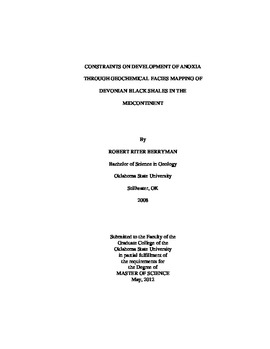| dc.contributor.advisor | Puckette, James O. | |
| dc.contributor.author | Berryman, Robert Riter | |
| dc.date.accessioned | 2014-03-14T21:51:10Z | |
| dc.date.available | 2014-03-14T21:51:10Z | |
| dc.date.issued | 2012-05-01 | |
| dc.identifier.uri | https://hdl.handle.net/11244/8001 | |
| dc.description.abstract | The Woodford Shale of the US southern Midcontinent is an Upper Devonian/Lower Mississippian black shale sequence that includes the Frasnian-Famennian boundary. Black shales are commonly enriched in transition metals. While the details of the chemical reactions and feedbacks responsible for trace metal enrichment are debated, these elements continue to be valuable for constraining paleoenvironmental conditions and potential source rock characteristics. While anoxic conditions are thought to favor the preservation of high concentrations of trace metals and total organic carbon (TOC), debate continues concerning the specific role of anoxia in the preservation of TOC, as well as the importance of eustatic sea-level shifts in the development of anoxia during Woodford Shale deposition--and by extension in other shale gas units. Metal/TOC ratios vary systematically with depth in these units within single outcrop, providing constraints on the role of bottom-water restriction in the development of these shales. Geographic variations in the concentrations of proxies for anoxia (i.e., higher trace metal concentrations at outcrops interpreted to be further from shore), TOC concentrations and shale lithologies provide evidence for a key role played by water-column productivity in the development of anoxia. Geochemical analysis of TOC concentrations and trace element ratios from Woodford Shale outcrops located at the McAlister Shale Pit in Carter County and at Highway 77D in Murray County in south-central Oklahoma, allowed for the placement of the two Woodford Shale outcrops onto an inferred depositional model. In this refined model, the 77D outcrop is located more proximal to the shoreline, in shallower waters, than the McAlister Shale Pit. Higher metal/Al ratios together with higher TOC concentrations are interpreted to indicate that the McAlister Shale Pit was located in generally deeper waters relative to 77D. | |
| dc.format | application/pdf | |
| dc.language | en_US | |
| dc.publisher | Oklahoma State University | |
| dc.rights | Copyright is held by the author who has granted the Oklahoma State University Library the non-exclusive right to share this material in its institutional repository. Contact Digital Library Services at lib-dls@okstate.edu or 405-744-9161 for the permission policy on the use, reproduction or distribution of this material. | |
| dc.title | Constraints on Development of Anoxia Through Geochemical Facies Mapping of Devonian Black Shales in the Midcontinent | |
| dc.type | text | |
| dc.contributor.committeeMember | Boardman, Darwin | |
| dc.contributor.committeeMember | Cruse, Anna | |
| osu.filename | Berryman_okstate_0664M_12048.pdf | |
| osu.college | Arts and Sciences | |
| osu.accesstype | Open Access | |
| dc.description.department | Boone Pickens School of Geology | |
| dc.type.genre | Thesis | |
| dc.subject.keywords | anoxia | |
| dc.subject.keywords | oklahoma | |
| dc.subject.keywords | shale | |
| dc.subject.keywords | trace metals | |
| dc.subject.keywords | woodford | |
